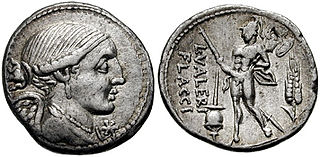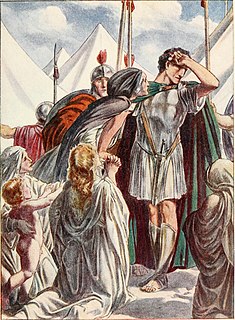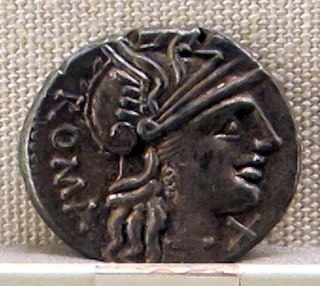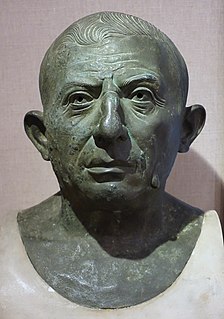Related Research Articles

The gens Valeria was a patrician family at ancient Rome, prominent from the very beginning of the Republic to the latest period of the Empire. Publius Valerius Poplicola was one of the consuls in 509 BC, the year that saw the overthrow of the Tarquins, and the members of his family were among the most celebrated statesmen and generals at the beginning of the Republic. Over the next ten centuries, few gentes produced as many distinguished men, and at every period the name of Valerius was constantly to be found in the lists of annual magistrates, and held in the highest honour. Several of the emperors claimed descent from the Valerii, whose name they bore as part of their official nomenclature.

The gens Licinia was a celebrated plebeian family at ancient Rome, which appears from the earliest days of the Republic until imperial times, and which eventually obtained the imperial dignity. The first of the gens to obtain the consulship was Gaius Licinius Calvus Stolo, who, as tribune of the plebs from 376 to 367 BC, prevented the election of any of the annual magistrates, until the patricians acquiesced to the passage of the lex Licinia Sextia, or Licinian Rogations. This law, named for Licinius and his colleague, Lucius Sextius, opened the consulship for the first time to the plebeians. Licinius himself was subsequently elected consul in 364 and 361 BC, and from this time, the Licinii became one of the most illustrious gentes in the Republic.

The gens Pompeia was a plebeian family at ancient Rome, first appearing in history during the second century BC, and frequently occupying the highest offices of the Roman state from then until imperial times. The first of the Pompeii to obtain the consulship was Quintus Pompeius in 141 BC, but by far the most illustrious of the gens was Gnaeus Pompeius, surnamed Magnus, a distinguished general under the dictator Sulla, who became a member of the First Triumvirate, together with Caesar and Crassus. After the death of Crassus, the rivalry between Caesar and Pompeius led to the Civil War, one of the defining events of the final years of the Roman Republic.
The gens Papiria was a patrician family at ancient Rome. According to tradition, the Papirii had already achieved prominence in the time of the kings, and the first Rex Sacrorum and Pontifex Maximus of the Republic were members of this gens. Lucius Papirius Mugillanus was the first of the Papirii to obtain the consulship in 444 BC. The patrician members of the family regularly occupied the highest offices of the Roman state down to the time of the Punic Wars. Their most famous member was Lucius Papirius Cursor, five times consul between 326 and 313 BC, who earned three triumphs during the Samnite Wars. Most of the Papirii who held office under the later Republic belonged to various plebeian branches of the family. Although the most illustrious Papirii flourished in the time of the Republic, a number of the family continued to hold high office during the first two centuries of the Empire.

The gens Cornelia was one of the greatest patrician houses at ancient Rome. For more than seven hundred years, from the early decades of the Republic to the third century AD, the Cornelii produced more eminent statesmen and generals than any other gens. At least seventy-five consuls under the Republic were members of this family, beginning with Servius Cornelius Maluginensis in 485 BC. Together with the Aemilii, Claudii, Fabii, Manlii, and Valerii, the Cornelii were almost certainly numbered among the gentes maiores, the most important and powerful families of Rome, who for centuries dominated the Republican magistracies. All of the major branches of the Cornelian gens were patrician, but there were also plebeian Cornelii, at least some of whom were descended from freedmen.

The gens Marcia, occasionally written Martia, was one of the oldest and noblest houses at ancient Rome. They claimed descent from the second and fourth Roman Kings, and the first of the Marcii appearing in the history of the Republic would seem to have been patrician; but all of the families of the Marcii known in the later Republic were plebeian. The first to obtain the consulship was Gaius Marcius Rutilus in 357 BC, only a few years after the passage of the lex Licinia Sextia opened this office to the plebeians.
The gens Terentia was a plebeian family at ancient Rome. Dionysius mentions a Gaius Terentius Arsa, tribune of the plebs in 462 BC, but Livy calls him Terentilius, and from inscriptions this would seem to be a separate gens. No other Terentii appear in history until the time of the Second Punic War. Gaius Terentius Varro, one of the Roman commanders at the Battle of Cannae in 216 BC, was the first to hold the consulship. Members of this family are found as late as the third century AD.
The gens Octavia was a plebeian family at ancient Rome, which was raised to patrician status by Caesar during the first century BC. The first member of the gens to achieve prominence was Gnaeus Octavius Rufus, quaestor circa 230 BC. Over the following two centuries, the Octavii held many of the highest offices of the state; but the most celebrated of the family was Gaius Octavius, the grandnephew and adopted son of Caesar, who was proclaimed Augustus by the senate in 27 BC.

The gens Minucia was an ancient Roman family, which flourished from the earliest days of the Republic until imperial times. The gens was apparently of patrician origin, but was better known by its plebeian branches. The first of the Minucii to hold the consulship was Marcus Minucius Augurinus, elected consul in 497 BC.
The gens Afrania was a plebeian family at Rome, which is first mentioned in the second century BC. The first member of this gens to achieve prominence was Gaius Afranius Stellio, who became praetor in 185 BC.

The gens Caecilia was a plebeian family at ancient Rome. Members of this gens are mentioned in history as early as the fifth century BC, but the first of the Caecilii who obtained the consulship was Lucius Caecilius Metellus Denter, in 284 BC. The Caecilii Metelli were one of the most powerful families of the late Republic, from the decades before the First Punic War down to the time of Augustus.
The gens Caelia was a plebeian family at ancient Rome. The nomen Caelius is frequently confounded with Coelius and Caecilius, with some individuals referred to as Caelius in manuscripts, while appearing as Coelius or Coilius on coins. Although the Caelii asserted their great antiquity, none of them attained any of the higher offices of the Roman state until the praetorship of Publius Caelius in 74 BC, and the first of this gens who obtained the consulship was Gaius Caelius Rufus in AD 17. The emperor Balbinus was a descendant of the Caelii.

The gens Pomponia was a plebeian family at ancient Rome. Its members appear throughout the history of the Roman Republic, and into imperial times. The first of the gens to achieve prominence was Marcus Pomponius, tribune of the plebs in 449 BC; the first who obtained the consulship was Manius Pomponius Matho in 233 BC.
The gens Cluvia was a plebeian family at ancient Rome, known from the later Republic, and early imperial times. The first member of the gens to achieve prominence was Gaius Cluvius Saxula, praetor in 175 and 173 BC.

The gens Curtia was an ancient but minor noble family at Rome, with both patrician and plebeian branches. The only member of the gens invested with the consulship under the Republic was Gaius Curtius Philo, in 445 BC. A few Curtii held lesser magistracies during the Republic, and there were two consuls suffectus in imperial times. However, the gens is best remembered from a series of legends dating from the traditional founding of the city to the early Republic.
The gens Gellia was a plebeian family at ancient Rome, where they settled after the Second Punic War. The first of the Gellii to obtain the consulship was Lucius Gellius Poplicola, in 72 BC, but the most famous member of this gens is probably the grammarian Aulus Gellius, who flourished during the second century AD.

The gens Munatia was a plebeian family at Rome. Members of this gens are first mentioned during the second century BC, but they did not obtain any of the higher offices of the Roman state until imperial times.
The gens Sallustia, occasionally written Salustia, was a plebeian family at ancient Rome. Members of this gens are first mentioned in the time of Cicero, and from that time they attained particular distinction as statesmen and writers. The most illustrious of the family was the historian Gaius Sallustius Crispus, who wrote valuable works on the Jugurthine War and the Conspiracy of Catiline, which still exist.
References
- 1 2 3 4 Dictionary of Greek and Roman Biography and Mythology , William Smith, Editor.
- ↑ Marcus Tullius Cicero, Pro Cluentio 48, Epistulae ad Atticum vi. 1.
- ↑ Titus Livius, Ab Urbe Condita x. 18-29.
- ↑ T. Robert S. Broughton, The Magistrates of the Roman Republic, American Philological Association (1952), vol. III, p. 84.
- ↑ Andrew Lintott, The Romans in the Age of Augustus, John Wiley & Sons (2009), p. 8.
- ↑ Titus Livius, Ab Urbe Condita Epitome lxxv.
- ↑ Appianus, Bellum Civile i. 40, 41, 45.
- 1 2 Marcus Tullius Cicero, Pro Cluentio 48.
- ↑ Plutarchus, Lives of the Noble Greeks and Romans Crassus 27.
- ↑ Marcus Tullius Cicero, Epistulae ad Atticum xiii. 34, 45 ff.
- ↑ Marcus Tullius Cicero, Epistulae ad Familiares xiii. 43-45, 47, 73, 74.
- ↑ Marcus Tullius Cicero, Epistulae ad Atticum vii. 18. § 4, x. 15. § 4, xi. 3. § 3, xii. 18. § 3.
- ↑ Marcus Tullius Cicero, Epistulae ad Atticum vi. 1. § 23.
- ↑ Appianus, Bellum Civile iv. 21.
- ↑ Marcus Velleius Paterculus, Compendium of Roman History ii. 91-93.
- ↑ Cassius Dio, Roman History liii. 24.
- ↑ Gaius Suetonius Tranquillus, De Vita Caesarum Augustus 19.
- ↑ Ambrosius Theodosius Macrobius, Saturnalia vi. 5.
- ↑ Publius Cornelius Tacitus, Annales xv. 71.
- ↑ Sextus Aurelius Victor, De Origo Gentis Romanae (attributed) init.
- ↑ Werner Eck, "Konsuln des Jahres 117 in Militärdiplomen Traians mit Tribunicia Potestas XX", Zeitschrift für Papyrologie und Epigraphik , 185 (2013), pp. 235–238
- ↑ Paul Leunissen, Konsuln und Konsulare in der Zeit von Commodus bis Severus Alexander (1989) pp. 196, 399
- ↑ CIL IX, 6414
- ↑ RE, vol. 5.2, col. 1999 (Egnatius 33).
- ↑ PIR2 E 1
- ↑ PIR2 E 36
- ↑ CIL VI, 30895, CIL X, 4752, CIL X, 1695, CIL X, 1696, CIL VI, 1723, CIL VI, 37112, CIL VI, 36951
- ↑ PLRE, vol. 1, pp. 512–514.
- ↑ CIL X, 1697, CIL VI, 32010
- ↑ PLRE, vol. 1, p. 514.
Works cited
 This article incorporates text from a publication now in the public domain : Smith, William, ed. (1870). Dictionary of Greek and Roman Biography and Mythology .
This article incorporates text from a publication now in the public domain : Smith, William, ed. (1870). Dictionary of Greek and Roman Biography and Mythology .{{cite encyclopedia}}: Missing or empty|title=(help)- Jones, A.H.M.; J.R. Martindale & J. Morris (1971–1992). Prosopography of the Later Roman Empire. Cambridge University Press. ISBN 0-521-07233-6.
- August Pauly; Georg Wissowa; Wilhelm Kroll; Kurt Witte; Karl Mittelhaus; Konrat Ziegler, eds. (1894–1980). Paulys Realencyclopädie der classischen Altertumswissenschaft. Stuttgart: J. B. Metzler.